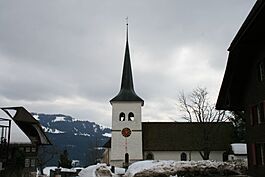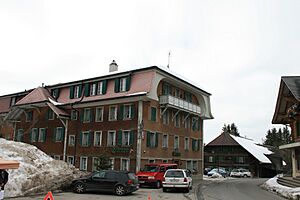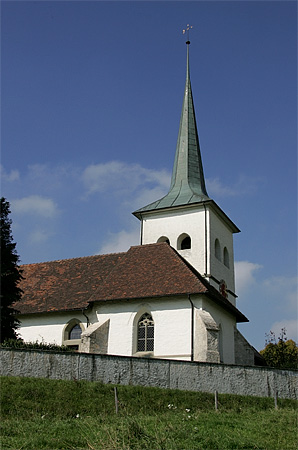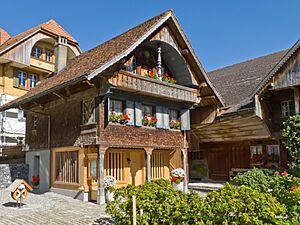Guggisberg facts for kids
Quick facts for kids
Guggisberg
|
||
|---|---|---|
 |
||
|
||
| Country | Switzerland | |
| Canton | Bern | |
| District | Bern-Mittelland | |
| Area | ||
| • Total | 54.91 km2 (21.20 sq mi) | |
| Elevation | 1,115 m (3,658 ft) | |
| Population
(Dec 2020 )
|
||
| • Total | 1,490 | |
| • Density | 27.14/km2 (70.28/sq mi) | |
| Postal code |
3158
|
|
| Surrounded by | Alterswil (FR), Oberwil im Simmental, Plaffeien (FR), Rüschegg, Schwarzenburg | |
Guggisberg is a small town, also called a municipality, in the Bern-Mittelland administrative district in the Swiss canton of Bern. It is known for its beautiful views and interesting history.
Contents
Guggisberg's Past: A Brief History
Guggisberg was first mentioned in old documents in 1076. Back then, it was called Mons Guchani. Later, in 1148, it appeared as Cucansperc in a document from Pope Eugene III.
How Guggisberg Was Divided and Reunited
In 1423, the area was split into two parts. These parts were sold to the cities of Bern and Fribourg. Guggisberg stayed divided until 1803. That's when Napoleon's Act of Mediation brought the two parts back together.
Challenges in the 19th Century
In the early 1800s, Guggisberg was a popular place for tourists. They came to see the Guggershorn mountain and other nearby peaks. However, things changed in 1819. The canton (like a state) started moving many poor people into the municipality.
There were also big food shortages in 1816-1818 and again in the 1840s. These problems made life very hard for the community. Many farmers had to sell their rights to use mountain pastures. Others left for America to escape poverty. By 1850, Guggisberg was the poorest municipality in the Canton of Bern. To help fix the economy, Guggisberg was split into two separate towns in 1860: Guggisberg and Rüschegg.
Exploring Guggisberg's Landscape
Guggisberg covers an area of about 54.9 square kilometers (about 21.2 square miles). A large part of the land is used for farming, about 52.5%. Forests cover another big part, about 39.5%.
What Guggisberg's Land Is Used For
About 3% of the land has buildings or roads. Rivers and lakes make up about 1.6%. The remaining 3.3% is land that cannot be used for farming or building.
Most of the forested land is dense forest. A small part has orchards or small groups of trees. For farming, some land is used for crops, while much of it is for pastures where animals graze.
Where Is Guggisberg Located?
Guggisberg is located in the alpine foothills. It is roughly halfway between the cities of Fribourg and Thun.
The municipality stretches from the Sense River, which forms the border with the Canton of Fribourg, up to the hills around the Stockhorn mountain chain. In the south, the land rises into the mountains. This area includes a mountain zone and the small village of Sangernboden. The northern part of Guggisberg is flatter. It has fields, villages, and farmhouses at elevations between 860 and 1120 meters (about 2,820 to 3,670 feet).
Who Lives in Guggisberg? Demographics
Guggisberg has a population of about 1,538 people. A small number of these residents, about 2.5%, are foreign nationals.
Languages Spoken in Guggisberg
Most people in Guggisberg speak German as their main language. About 98.1% of the population speaks German. A few people also speak English or French.
Age Groups in the Community
In Guggisberg, children and teenagers (ages 0–19) make up about 21.6% of the population. Adults (ages 20–64) are the largest group, at 57.5%. Seniors (over 64 years old) make up about 20.9% of the population.
How Guggisberg's Population Has Changed Over Time
The chart below shows how the number of people living in Guggisberg has changed through the years.

Guggisberg's Economy: How People Work
In Guggisberg, most people work in three main areas:
- Primary sector: This includes jobs like farming, forestry, and fishing. Many people in Guggisberg work in agriculture.
- Secondary sector: This involves manufacturing (making things) and construction (building things).
- Tertiary sector: This covers service jobs. Examples include working in shops, restaurants, transportation, education, and healthcare.
Where Do Guggisberg Residents Work?
Many people who live in Guggisberg also work there. However, more people leave Guggisberg to work in other towns than people who come into Guggisberg for work. This means Guggisberg is a "net exporter" of workers.
Most workers use a private car to get to work. A smaller number use public transportation.
Religion in Guggisberg
Most people in Guggisberg belong to the Swiss Reformed Church. This is a Protestant Christian church. A smaller number of people are Roman Catholic. There are also some people who belong to other Christian churches or other religions. Some residents do not belong to any church.
Learning in Guggisberg: Education
In Guggisberg, many adults have finished high school. Some have also gone on to higher education, like a university or a specialized college.
The School System in Bern Canton
The school system in the Canton of Bern works like this:
- First, there is one year of optional Kindergarten.
- Then, students go to Primary school for six years.
- After that, they attend three years of lower Secondary school. In secondary school, students are grouped based on their abilities.
- After lower Secondary school, students can choose to continue their education or start an apprenticeship (learning a trade on the job).
Students in Guggisberg Schools
During the 2011-2012 school year, there were 132 students in Guggisberg schools. This included one kindergarten class and six primary school classes. There were also two lower secondary classes. Most students who live in Guggisberg also go to school there.
Famous People from Guggisberg
- de:Adrian Guggisberg (born 1943), a Swiss politician.
- de:Charles Albert Walter Guggisberg (1913-1980), a Swiss zoologist and author.
- Lady Decima Moore-Guggisberg (1871-1964), a British actress.
- Sir Frederick Gordon Guggisberg (1869-1930), a British Brigadier-General and colonial governor. He was also an author.
- de:Gunvor Guggisberg (born 1974), a Swiss entertainer.
- de:Peter Guggisberg (born 1985), a Swiss hockey player.
- Ron Guggisberg, a state legislator in North Dakota, USA.
- de:Ulrich Guggisberg (born 1947), a Swiss soccer player.
Guggisberg's Coat of Arms
The blazon (description) of Guggisberg's coat of arms shows a girl in traditional local clothing. She stands on a green hill and holds a red rose with green leaves.
Important Historical Sites
The Trifelers Babis Stöckli house, located at Dorf 74, is a very important historical building in Switzerland. It is listed as a heritage site of national significance. The entire village of Guggisberg is also part of the Inventory of Swiss Heritage Sites, meaning it has important historical and cultural value.
See also
 In Spanish: Guggisberg para niños
In Spanish: Guggisberg para niños








